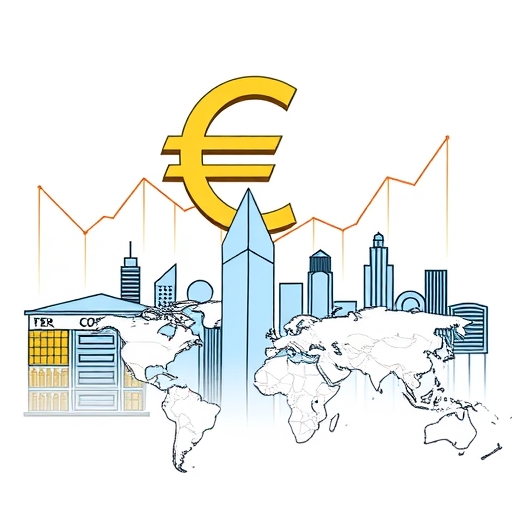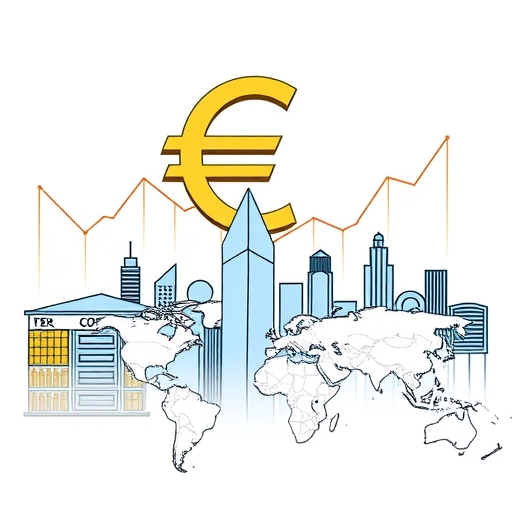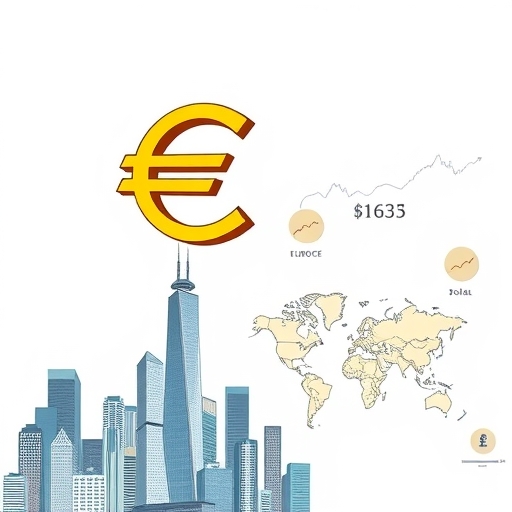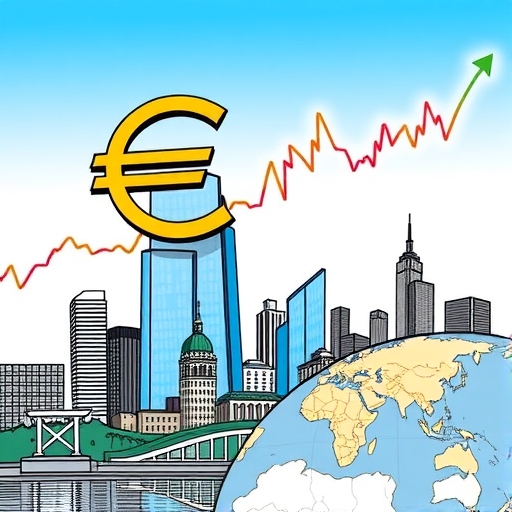
Understanding Euro Currency: Why It’s Challenging Dollar Dominance Now
Table of Contents
ToggleThe Euro’s Ascent: Navigating Global Shocks and Challenging Dollar Dominance
The global financial landscape is experiencing a profound recalibration. For decades, the U.S. Dollar has stood as the undisputed titan, the bedrock of international finance. However, as investors and central bankers keenly observe the shifting global currents, the Euro is increasingly asserting itself as a formidable force, challenging this long-held dominance. What drives this pivotal shift? Is it merely a temporary fluctuation, or are we witnessing a fundamental re-evaluation of trust in global reserve assets?
This article aims to provide you with a comprehensive understanding of the forces propelling the Euro’s recent gains, dissect the underlying vulnerabilities that are chipping away at the Dollar’s global standing, and explore the strategic initiatives poised to solidify the Euro’s position as a stable and preferred alternative in the international financial system. As aspiring traders and seasoned investors, grasping these macro-level shifts is crucial for informed decision-making and navigating the complexities of the foreign exchange market.
- The Euro is increasingly viewed as a stable alternative to the Dollar.
- Investors are shifting portfolios away from the Dollar due to geopolitical uncertainties.
- The Eurozone’s economic integration enhances the Euro’s appeal as a reserve currency.
Unpacking the Euro’s Surge: Geopolitical Catalysts and Investor Realignment
Have you been observing the charts? The Euro has seen significant gains against the U.S. Dollar, with some estimates projecting approximate gains of 14% by 2025. This isn’t random market noise; it’s a reflection of deeper geopolitical and economic shifts. A primary driver is the palpable uncertainty emanating from U.S. policy, particularly around President Trump’s tariff policies. Such measures, often unpredictable and unilateral, inject substantial volatility into global trade and investment flows. When the world’s largest economy adopts protectionist stances, it inevitably creates jitters, pushing investors to seek safer harbors.
Think of it like this: if you were managing a vast portfolio, wouldn’t you re-evaluate exposure to an asset whose underlying government policies were causing widespread unpredictability? This is precisely what’s happening. Central bankers, custodians of national wealth, increasingly view the Euro as a more stable alternative to the Dollar. While the Euro is far from immediately replacing the Dollar as the top global reserve asset, this perception of stability is a powerful magnet for capital. This “readjustment” of portfolios isn’t just a reaction to tariffs; it’s a response to a perceived weakening of the rule of law in the United States, which, as many investors understand, can pose a greater risk to U.S. asset holdings over time. This foundational shift in trust is a cornerstone of the Euro’s newfound strength.

Furthermore, the shift has implications for global market stability and investor behavior. Traders should consider the following:
- The impact of central bank policies on currency strength.
- The relationship between political stability and investor confidence.
- The importance of understanding macroeconomic indicators.
The Dollar’s Enduring Pressure Points: Fiscal Sustainability and Institutional Integrity
While the Euro gains ground, the U.S. Dollar finds itself under mounting pressure from several domestic fronts. Beyond tariffs, two critical issues erode confidence in the Greenback: fiscal sustainability concerns and attacks on venerable institutions like the Federal Reserve. Consider the impact of a sweeping tax bill, for instance. While designed to stimulate the economy, such measures can significantly increase the federal deficit. A ballooning deficit raises questions about a nation’s ability to manage its finances responsibly in the long run, and investors, always forward-looking, factor this into their currency valuations.
Governor Yannis Stournaras of the Central Bank of Greece highlighted this concern, noting that U.S. tariff policies combined with worries over fiscal sustainability explain the Dollar’s recent evolution. This has tangible consequences: the Dollar’s share in global foreign exchange reserves has declined from 68.8% in 2014 to 57.8% by the end of 2024. In contrast, the Euro’s share has held remarkably steady, hovering around a fifth for over a decade. This divergence signals a slow but persistent diversification away from the Dollar.
| Year | Dollar’s Share (%) | Euro’s Share (%) |
|---|---|---|
| 2014 | 68.8 | 20 |
| 2024 | 57.8 | 20 |
Furthermore, any perceived erosion of the rule of law or direct political interference with independent institutions like the Federal Reserve can profoundly impact investor confidence. These institutions provide stability and predictability in monetary policy. When their independence is questioned, it introduces systemic risk. Foreign investors are increasingly reluctant, no longer buying enough dollar assets to finance America’s huge current account deficit. This underscores the Dollar’s “newfound fragility” and creates a significant opening for the Euro to fill the void.
The Anatomy of Reserve Currencies: What Drives Global Trust?
What makes a currency a truly global reserve currency? It’s more than just economic size; it’s about deep markets, convertibility, trust, and predictability. For decades, the U.S. Dollar epitomized these qualities, making it the preferred currency for international trade, finance, and foreign exchange reserves. However, as we’ve seen, shifts in policy and perception can challenge even the most entrenched positions. The role of a reserve currency is to provide stability and liquidity to the global financial system, acting as a safe haven during times of crisis. When these core attributes are questioned, countries and institutions begin to diversify their holdings.
The Euro’s consistent share in global foreign exchange reserves, despite the Dollar’s fluctuations, underscores its inherent stability and the trust it commands. This isn’t accidental; it’s a testament to the robust institutional framework of the Eurozone and the clear, albeit sometimes complex, decision-making processes of the European Central Bank (ECB). While the Euro is still far from achieving parity with the Dollar in overall reserve holdings, its consistent performance and increasing appeal signal a strategic opportunity. This demands deeper financial markets and enhanced attractiveness as an investment vehicle, making it easier for foreign entities to hold and transact in Euro-denominated assets. We are witnessing a slow but steady re-evaluation by global central bankers and sovereign wealth funds, moving beyond the traditional reliance on a single dominant currency towards a more diversified, multi-polar currency system.

In summary, the dynamics of reserve currencies hinge on factors such as:
- Market depth and liquidity.
- Stability and trust in governmental institutions.
- Global economic conditions and diversification efforts.
Divergent Monetary Paths: ECB vs. Federal Reserve
Monetary policy, managed by central banks, plays a crucial role in currency valuations. Interestingly, despite recent Euro gains, the European Central Bank (ECB) has kept benchmark interest rates on hold, signaling a cautious approach, while the Federal Reserve (Fed) has also held steady. You might wonder, how can the Euro gain strength when the ECB isn’t actively raising rates to attract capital? This highlights that currency movements are influenced by a multitude of factors, not just interest rate differentials.
One key factor supporting the Euro’s strength is the expectation of future fiscal boosts within the European Union. Initiatives like the NextGenerationEU stimulus project, designed to foster recovery and resilience, are expected to significantly increase Euro-denominated borrowing in the coming years. This surge in Euro-denominated debt can naturally boost demand for the currency. Moreover, recent economic indicators from the Eurozone are painting a more optimistic picture. European growth, as per HCOB PMIs, has reached its highest in almost a year. Stronger economic performance tends to bolster a currency’s value, as it signals a healthy investment environment.
| Key Economic Indicators | Current Value | Trend |
|---|---|---|
| HCOB PMIs | Highest in Almost a Year | Increasing |
| Euro-denominated Debt | Expected to Significantly Increase | Rising Demand |
Contrast this with the U.S. economic narrative, where concerns about fiscal deficits and political stability are more pronounced. While the Fed’s stance on interest rates is critical, the broader macro environment, including trade policies and geopolitical risks, also plays a significant role. This divergence in both actual economic performance and the perception of future policy direction contributes to the Euro’s growing appeal. It’s a complex dance of various economic and political forces, where the underlying fundamentals and perceived stability can sometimes outweigh immediate interest rate differentials.
Building Blocks for Euro’s Future: Banking and Capital Markets Union
For the Euro to solidify its international role and truly become a stronger contender as a global reserve currency, deeper economic integration within the European Union is paramount. Two critical initiatives stand out: the completion of the Banking Union and the establishment of a robust Capital Markets Union. What do these mean for the Euro’s strength?
The Banking Union aims to create a more resilient and integrated banking sector across the Eurozone, reducing fragmentation and enhancing financial stability. A stronger banking system means a more reliable conduit for capital flows and a reduced risk of financial crises that could undermine confidence in the currency. It ensures that banks are supervised consistently and that there are mechanisms for resolving failing banks without resorting to taxpayer bailouts, thus insulating the broader economy.
Similarly, the Capital Markets Union seeks to break down barriers to cross-border investment within the EU, fostering a deeper and more integrated capital market. Imagine capital flowing freely and efficiently across national borders within the Eurozone, similar to within the United States. This would provide European businesses with more diverse funding options, encourage innovation, and make European markets more attractive to global investors. A deeper, more liquid capital market naturally increases the demand for and use of the Euro, enhancing its global reach and appeal. These initiatives, while complex and requiring significant political will, are crucial for building robust foundations for the Euro, fostering internal stability, and boosting Euro-denominated borrowing, ultimately cementing its position on the world stage.
NextGenerationEU: A Fiscal Catalyst for Euro Strength
Beyond the structural reforms of the Banking and Capital Markets Unions, the European Union has also unleashed a powerful fiscal tool in the form of the NextGenerationEU stimulus project. This ambitious recovery plan, designed to address the economic fallout from the Covid-19 pandemic and build a greener, more digital Europe, represents a significant stride towards greater fiscal integration within the bloc. How does this impact the Euro?
The sheer scale of NextGenerationEU means the EU will undertake substantial joint borrowing in financial markets, issuing a significant amount of Euro-denominated bonds. This collective issuance achieves several critical objectives. Firstly, it substantially increases the supply of highly liquid, safe Euro-denominated assets, which are attractive to global investors seeking diversification from traditional Dollar-denominated assets. Secondly, it signals a deeper level of fiscal solidarity and integration among member states, which can only enhance confidence in the long-term stability and cohesion of the Eurozone. As Deutsche Bank strategists George Saravelos and Christian Wietoska noted, this effectively creates a “new safe asset” in Europe, boosting the supply of Euro-denominated bonds and naturally supporting the currency.

This increased Euro-denominated borrowing creates a positive feedback loop: higher demand for these bonds means more capital flowing into the Eurozone, further bolstering the Euro’s value. It transforms the Euro from merely a common currency into a vehicle for collective fiscal action, a powerful statement of unity and financial resilience. This collective approach to fiscal stimulus provides a stark contrast to the often fragmented or unilateral policy actions observed elsewhere, further solidifying the Euro’s appeal as a stable and coordinated economic bloc.
Pioneering the Future: The Digital Euro Initiative
As the world hurtles towards a more digitized economy, the concept of cash, while still vital, is gradually evolving. Recognizing this shift, the European Central Bank (ECB) is actively preparing for a possible digital Euro. This isn’t just a technological upgrade; it’s a strategic move to future-proof the currency and ensure it remains relevant and competitive in an evolving payment landscape. What does a digital Euro mean for you and the broader financial system?
A digital Euro would offer a secure, cost-free, and Europe-wide payment option, designed for both online and offline transactions. Think of it as electronic cash, issued and backed by the central bank, carrying the same trust and stability as physical banknotes and coins. This initiative is about providing choice and ensuring that European citizens and businesses have access to a sovereign digital payment method, rather than relying solely on private digital currencies or foreign payment systems. This move is crucial for maintaining monetary sovereignty and ensuring financial stability in the digital age.
Beyond the practical benefits, the development of a digital Euro reinforces the Eurozone’s commitment to innovation and leadership in global finance. It signals a forward-thinking approach, recognizing that a modern currency must adapt to changing user needs and technological advancements. This proactive stance, combined with the structural reforms and fiscal initiatives discussed earlier, paints a picture of a Euro that is not only stable in the present but also strategically positioned for the future, ready to meet the demands of a rapidly digitizing global economy.
Navigating Volatility: Trade Deals and Market Reactions
The currency markets, particularly the EUR/USD pair, are highly sensitive to developments in international trade and geopolitical events. While the overarching narrative points to the Euro’s strengthening global importance, short-term fluctuations are common and often driven by specific news. Consider the impact of major trade deals: a U.S.-Japan trade deal or the potential for a U.S.-European Union trade deal can immediately influence exchange rates. Why?
Because trade deals impact economic growth forecasts, tariff regimes, and the overall flow of goods and services between economies. A deal that benefits one region’s exports might strengthen its currency, while uncertainty or negative outcomes could weaken it. For instance, ING FX Strategist Francesco Pesole observed that the EUR/USD pair was reacting to trade updates, indicating how quickly the market processes new information. We also saw temporary boosts to the Dollar due to rising geopolitical risk and oil prices – traditional safe-haven flows – which then reverted as the focus shifted back to underlying fundamentals.
- Trade negotiations can create quick shifts in currency valuations.
- Understanding economic indicators helps to predict market movements.
- Traders need to stay informed about geopolitical developments.
This highlights a crucial lesson for traders: while macro trends dictate the long-term direction, daily news and market sentiment can create significant short-term volatility. Staying informed about geopolitical developments, trade negotiations, and key economic data releases (like Purchasing Managers’ Indexes or Initial Jobless Claims) is paramount. Understanding how these events trigger market reactions, sometimes counter-intuitively, allows you to better anticipate price movements and manage your risk exposure. It underscores the dynamic interplay between fundamental factors and market psychology, a constant dance that defines the foreign exchange market.
Empowering Your Trading Journey: Capitalizing on Macro Trends
As aspiring or experienced traders, how do you translate these profound macro-economic and geopolitical shifts into actionable strategies? Understanding the Euro’s ascent and the Dollar’s evolving role is not just academic; it provides a powerful framework for anticipating market movements. The shift away from the Dollar, driven by factors like U.S. tariff policies, fiscal sustainability concerns, and a perceived weakening of the rule of law, signifies a fundamental reassessment by global investors. This leads to a “readjustment” of portfolios, away from what is perceived as higher risk in U.S. asset holdings and towards more stable alternatives.
This macro-level analysis suggests that the long-term trend for the EUR/USD pair might be towards a stronger Euro. For you, this means potentially looking for opportunities to trade in alignment with this trend. However, remember that no market moves in a straight line. Volatility will persist, driven by trade negotiations, monetary policy announcements, and unexpected global events. Therefore, combining this fundamental macro understanding with robust risk management and technical analysis strategies becomes critical.
When foreign entities are no longer buying enough dollar assets to finance America’s huge current account deficit, it points to a structural weakness in the Dollar. Conversely, the European Central Bank and political leaders are actively working to capitalize on the Euro’s boosting global standing through deeper integration, stimulus projects like NextGenerationEU, and future-proofing initiatives like the digital Euro. These concerted efforts create a compelling bullish case for the Euro over the medium to long term.
If you’re considering entering the world of foreign exchange trading or exploring a wider range of Contracts for Difference (CFD) products, then Moneta Markets is a platform worth considering. Hailing from Australia, it offers over 1000 financial instruments, providing suitable options for both novice and experienced traders.
Beyond Exchange Rates: Tangible Benefits for European Life and Business
While we often discuss the Euro in terms of exchange rates and global reserves, its impact on the daily lives of citizens and businesses within the Eurozone is profound and tangible. The Euro is not just a currency; it’s a powerful symbol of European unity and integration, bringing 350 million people across 20 EU countries together. What does this mean for you, whether you live, work, or travel within this vast economic area?
Firstly, the Euro facilitates significantly easier living, working, and studying abroad within the Eurozone. Imagine traveling across 20 countries without needing to exchange currency every time you cross a border, avoiding conversion fees and the hassle of different denominations. This convenience encourages tourism, boosts cultural exchange, and simplifies cross-border living for millions. Secondly, for businesses, the benefits are even more pronounced. The Euro dramatically reduces currency conversion costs and risks associated with exchange rate fluctuations when trading across member states. This certainty encourages investment, streamlines supply chains, and fosters a more competitive single market.
| Impact on Daily Life | Description |
|---|---|
| Travel | No need to exchange currency between Eurozone countries. |
| Businesses | Reduction in currency conversion costs. |
By eliminating currency barriers, the Euro helps businesses expand, access larger markets, and innovate more freely. This shared currency fosters greater transparency in pricing, allowing consumers to compare prices more easily across countries, ultimately driving efficiency and benefiting the end-user. Recent historical events, such as Croatia adopting the Euro and simultaneously joining the Schengen zone, further demonstrate the Euro’s expanding reach and its role as a catalyst for deeper integration, providing concrete evidence of its unifying power and ongoing benefits.
Conclusion: The Euro’s Evolving Narrative in a Multipolar World
The narrative of currency dominance is undeniably shifting. While the U.S. Dollar continues to hold significant weight, it faces persistent headwinds from domestic policy uncertainties, fiscal sustainability concerns, and a waning appetite for its assets among global investors. This “newfound fragility” of the Dollar presents a pivotal moment in global finance, and the Euro is strategically positioned to capitalize on this rebalancing act.
Through sustained efforts in economic integration, robust policymaking exemplified by initiatives like the Banking Union, the Capital Markets Union, and the transformative NextGenerationEU project, the European Central Bank and political leaders are actively shaping a future where the Euro plays an increasingly pivotal and influential role. Furthermore, the proactive development of a digital Euro underscores a commitment to innovation, ensuring the currency remains relevant and resilient in the face of technological evolution.
As we have explored, the Euro is demonstrating not only resilience and growing appeal as a stable, integrated, and forward-looking currency but also tangible benefits for millions of people and businesses. For you, whether you are a new investor taking your first steps or an experienced trader seeking deeper insights, understanding these macro trends is vital. The ongoing evolution of the global currency landscape offers both challenges and compelling opportunities, and the Euro’s story is undoubtedly one of ascendance in an era of geopolitical and economic flux. Staying informed and adaptable will be your greatest assets in this dynamic environment.
In your search for a forex broker with robust regulatory oversight and global trading capabilities, Moneta Markets is a prime candidate. It boasts multi-jurisdictional regulatory certifications including FSCA, ASIC, and FSA, and offers comprehensive support packages such as segregated client funds, free VPS services, and 24/7 Chinese customer support, making it a preferred choice for many traders.
understanding euro currencyFAQ
Q:What factors contribute to the Euro’s rise against the Dollar?
A:The Euro’s rise is fueled by geopolitical stability, diversification away from the Dollar, and the perception of stronger fiscal policies in the Eurozone.
Q:How does the Euro affect daily life in the Eurozone?
A:The Euro simplifies cross-border travel and trade by eliminating currency conversion costs, enhancing economic integration.
Q:What is the significance of the NextGenerationEU initiative?
A:NextGenerationEU represents a major fiscal tool for recovery and integration, increasing the supply of Euro-denominated assets and boosting investor confidence.
You may also like
Calendar
| 一 | 二 | 三 | 四 | 五 | 六 | 日 |
|---|---|---|---|---|---|---|
| 1 | 2 | 3 | 4 | 5 | 6 | 7 |
| 8 | 9 | 10 | 11 | 12 | 13 | 14 |
| 15 | 16 | 17 | 18 | 19 | 20 | 21 |
| 22 | 23 | 24 | 25 | 26 | 27 | 28 |
| 29 | 30 | 31 | ||||
發佈留言
很抱歉,必須登入網站才能發佈留言。